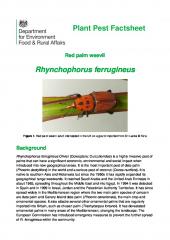A native to tropical Southeastern Asia, Metroxylon sagu or commonly known as Sago Palm is a multiple-stemmed palm growing about 25 m in height. It has an upright terminal inflorescence and pinnate leaves. The fruit is drupe-like and covered in scales. The trunk is the main source of a starch known as sago which is used in cooking and as food thickener. The apical bud is cooked or consumed raw. The leaves are used as thatching material, or weaved into baskets and mats. The bark can be used as fuel or as flooring material.
Metroxylon sagu is an evergreen Tree growing to 10 m by 10 m at a medium rate.
It is hardy to zone 10. The plant is not self-fertile.
Suitable for: light , medium and heavy soils and can grow in heavy clay soil. Suitable pH: acid, neutral and basic soils and can grow in very acid and saline soils.
It cannot grow in the shade. It prefers moist or wet soil. The plant can tolerate maritime exposure.
Agroforestry Services: Windbreak Fodder: Insect Industrial Crop: Fiber Management: Managed Multistem Regional Crop Staple Crop: Basic Starch
Sago palm succeeds in wet, lowland tropical climates where it is found at elevations from sea level to 700 metres. It grows best in areas where annual daytime temperatures are within the range 25 - 36°c, but can tolerate 18 - 40°c. When dormant, the plant can survive temperatures down to about 10°c. It prefers a mean annual rainfall in the range 3,000 - 4,500mm, but tolerates 2,100 - 5,800mm. Plants grow well in full sun, even when small. They grow best in clay soils with a high organic-matter content. In the wild, the plant grows on mineral rich soils with a pH of 4.5 or more. Prefers a pH in the range 5.5 - 6.5, tolerating 4.5 - 8.5. Plants can be grown in soils with very high water tables, succeeding even in swamps. They can even tolerate occasional flooding with saline water. Sago palm is hapaxanthic. Each trunk lives for a number of years without flowering but, once it has flowered and fruited, the leaves senesce and the trunk dies completely. However, one or more suckers develop from the base and take over. The vegetative growth phase lasts for at least 8 years before the tree flowers. A single palm may yield about 180 - 350 kilos of sago. It has been calculated that the labour requirement for each kilo of starch obtained from this plant is far less than for any other starch producing plant. There are hermaphroditic and male flowers. The palm can be classified as a nearly complete obligatory cross-breeder, with easy vegetative multiplication. Spacing: 15-20 ft. 20-30 ft. 30-40 ft. .
Habitatspreferably on mineral soils with a pH higher than 4.5.
Resources
Rhynchophorus ferrugineus Defra PP Factsheet Oct 2016 FINAL4

Red palm weevil
Rhynchophorus ferrugineus
Figure 1. Red palm weevil adult intercepted in the UK on a gourd imported from Sri Lanka © Fera
Background
https://planthealthportal.defra.gov.uk/assets/factsheets/Rhynchophorus-ferrugin…Rhynchophorus ferrugineus Defra PP Factsheet Oct 2016 FINAL4Rhynchophorus ferrugineus Defra PP Factsheet Oct 2016 FINAL4
Red palm weevil
UK Plant Health Information Portal
Rhynchophorus ferrugineus
Figure 1. Red palm weevil adult intercepted in the UK on a gourd imported from Sri Lanka © Fera
Background
